Artificial Intelligence on Emerging Trends of Technology
VerifiedAdded on 2021/06/15
|21
|1514
|210
Presentation
AI Summary
Contribute Materials
Your contribution can guide someone’s learning journey. Share your
documents today.

Artificial Intelligence on
Emerging Trends of
Technology
Name of the Student
Name of the University
Emerging Trends of
Technology
Name of the Student
Name of the University
Secure Best Marks with AI Grader
Need help grading? Try our AI Grader for instant feedback on your assignments.
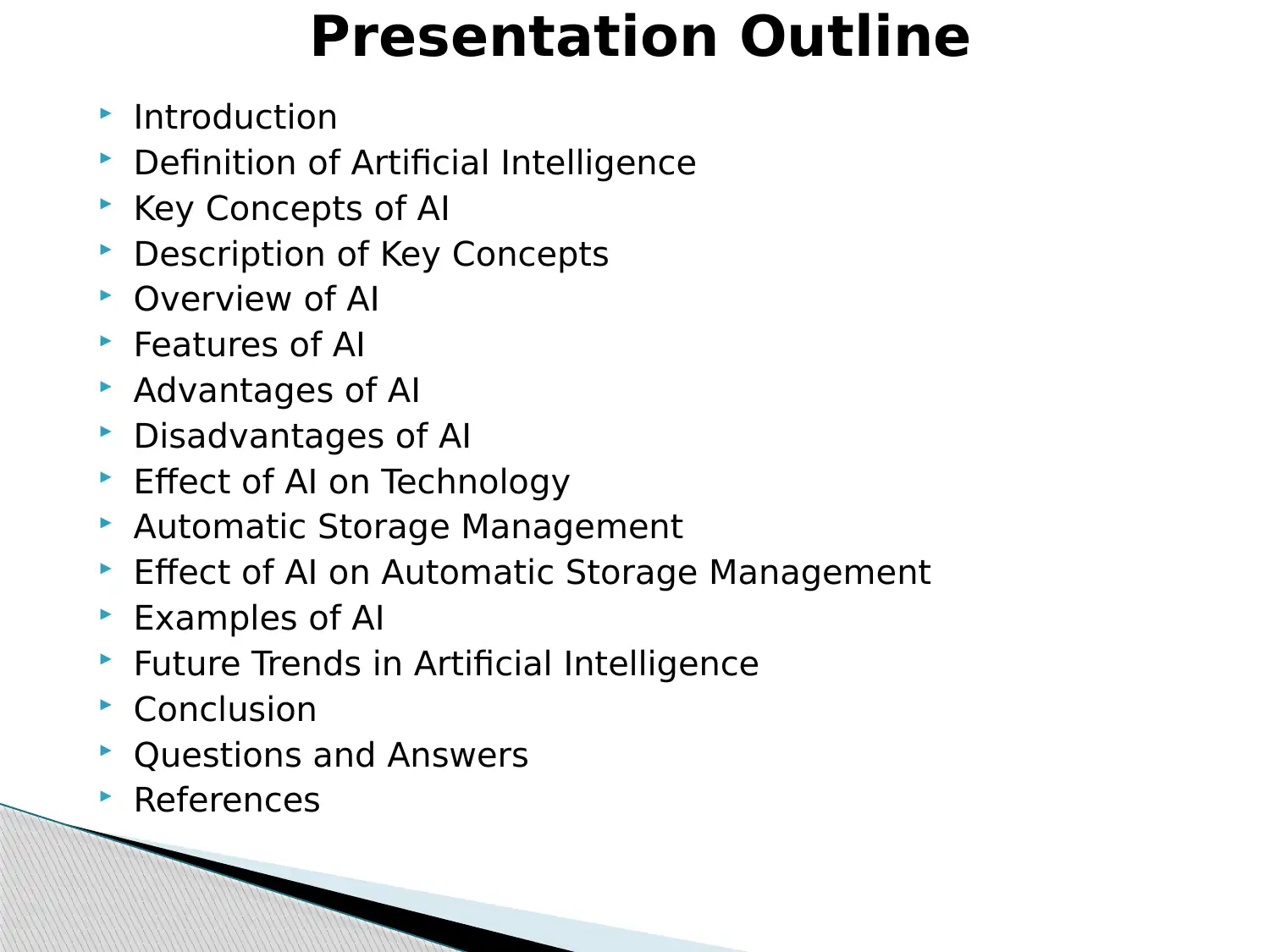
Introduction
Definition of Artificial Intelligence
Key Concepts of AI
Description of Key Concepts
Overview of AI
Features of AI
Advantages of AI
Disadvantages of AI
Effect of AI on Technology
Automatic Storage Management
Effect of AI on Automatic Storage Management
Examples of AI
Future Trends in Artificial Intelligence
Conclusion
Questions and Answers
References
Presentation Outline
Definition of Artificial Intelligence
Key Concepts of AI
Description of Key Concepts
Overview of AI
Features of AI
Advantages of AI
Disadvantages of AI
Effect of AI on Technology
Automatic Storage Management
Effect of AI on Automatic Storage Management
Examples of AI
Future Trends in Artificial Intelligence
Conclusion
Questions and Answers
References
Presentation Outline
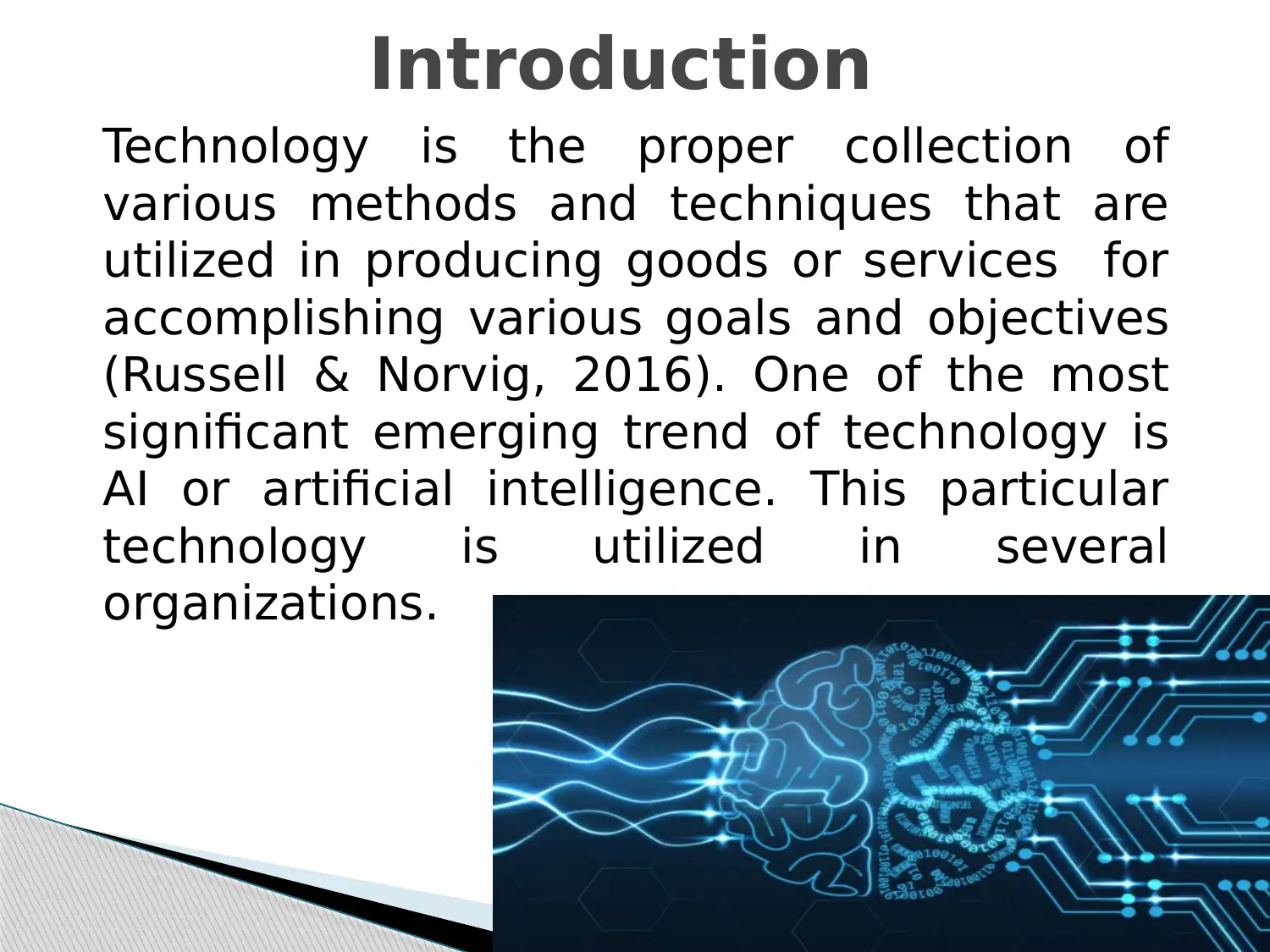
Technology is the proper collection of
various methods and techniques that are
utilized in producing goods or services for
accomplishing various goals and objectives
(Russell & Norvig, 2016). One of the most
significant emerging trend of technology is
AI or artificial intelligence. This particular
technology is utilized in several
organizations.
Introduction
various methods and techniques that are
utilized in producing goods or services for
accomplishing various goals and objectives
(Russell & Norvig, 2016). One of the most
significant emerging trend of technology is
AI or artificial intelligence. This particular
technology is utilized in several
organizations.
Introduction
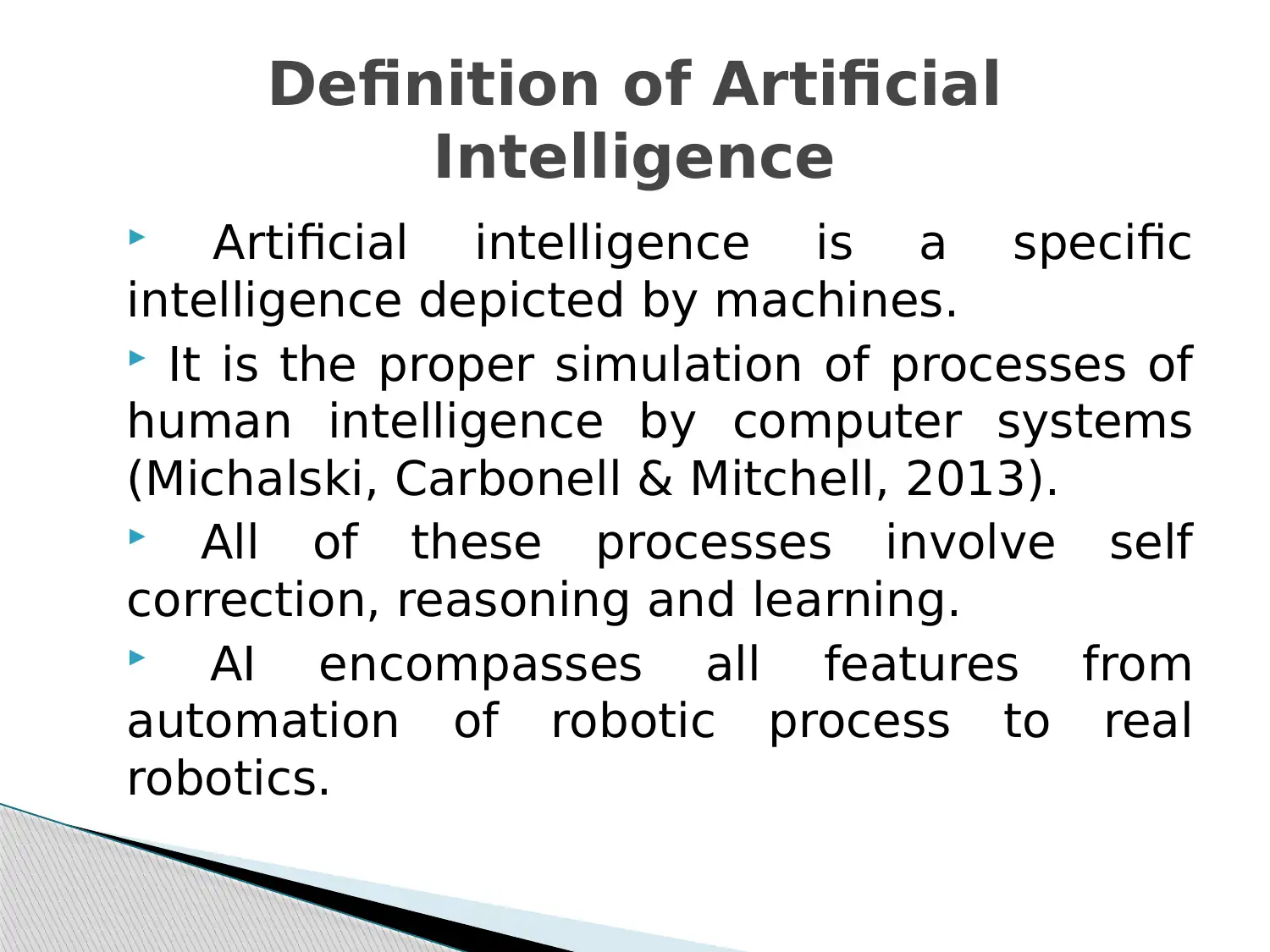
Artificial intelligence is a specific
intelligence depicted by machines.
It is the proper simulation of processes of
human intelligence by computer systems
(Michalski, Carbonell & Mitchell, 2013).
All of these processes involve self
correction, reasoning and learning.
AI encompasses all features from
automation of robotic process to real
robotics.
Definition of Artificial
Intelligence
intelligence depicted by machines.
It is the proper simulation of processes of
human intelligence by computer systems
(Michalski, Carbonell & Mitchell, 2013).
All of these processes involve self
correction, reasoning and learning.
AI encompasses all features from
automation of robotic process to real
robotics.
Definition of Artificial
Intelligence
Secure Best Marks with AI Grader
Need help grading? Try our AI Grader for instant feedback on your assignments.
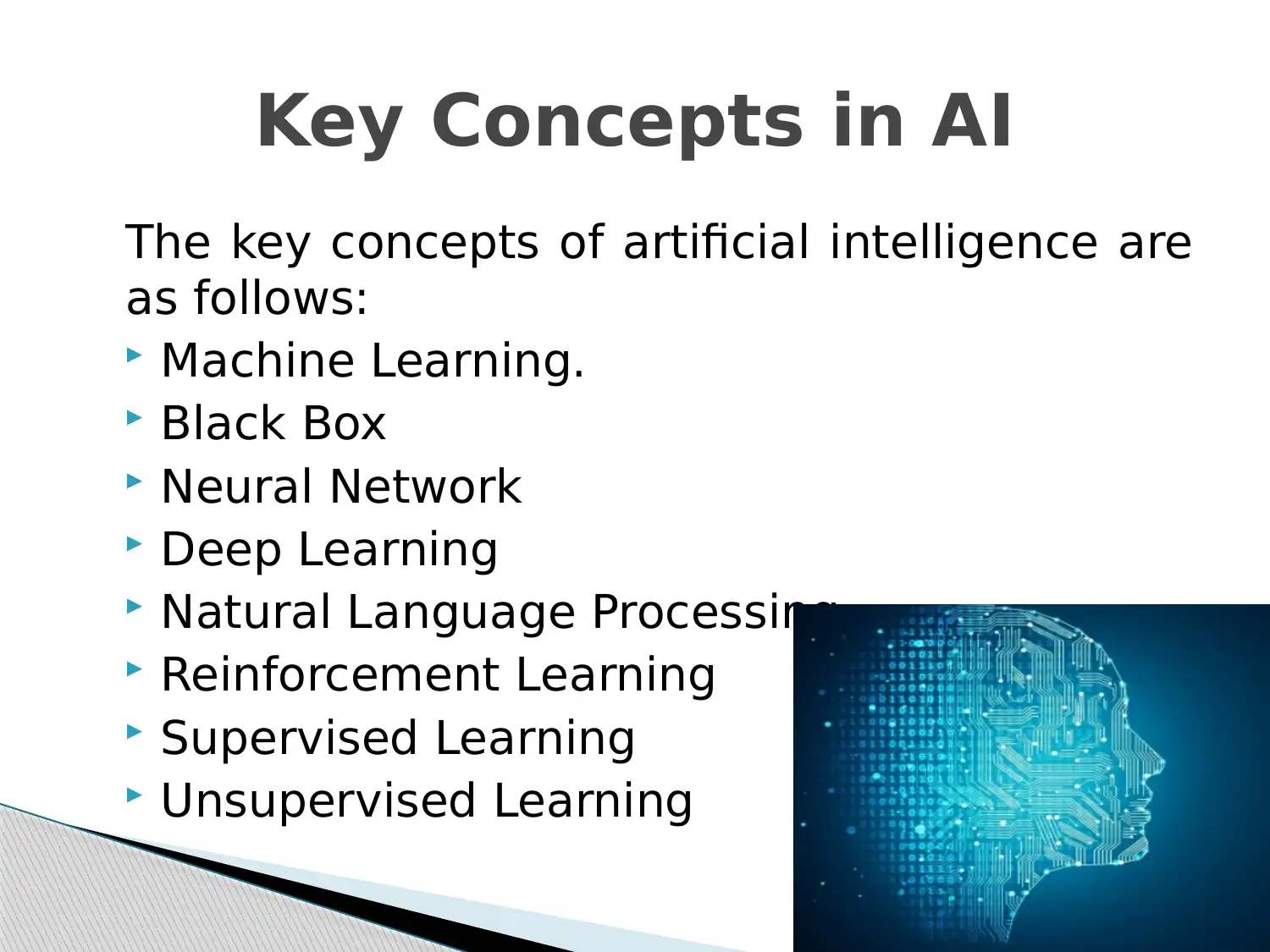
The key concepts of artificial intelligence are
as follows:
Machine Learning.
Black Box
Neural Network
Deep Learning
Natural Language Processing
Reinforcement Learning
Supervised Learning
Unsupervised Learning
Key Concepts in AI
as follows:
Machine Learning.
Black Box
Neural Network
Deep Learning
Natural Language Processing
Reinforcement Learning
Supervised Learning
Unsupervised Learning
Key Concepts in AI
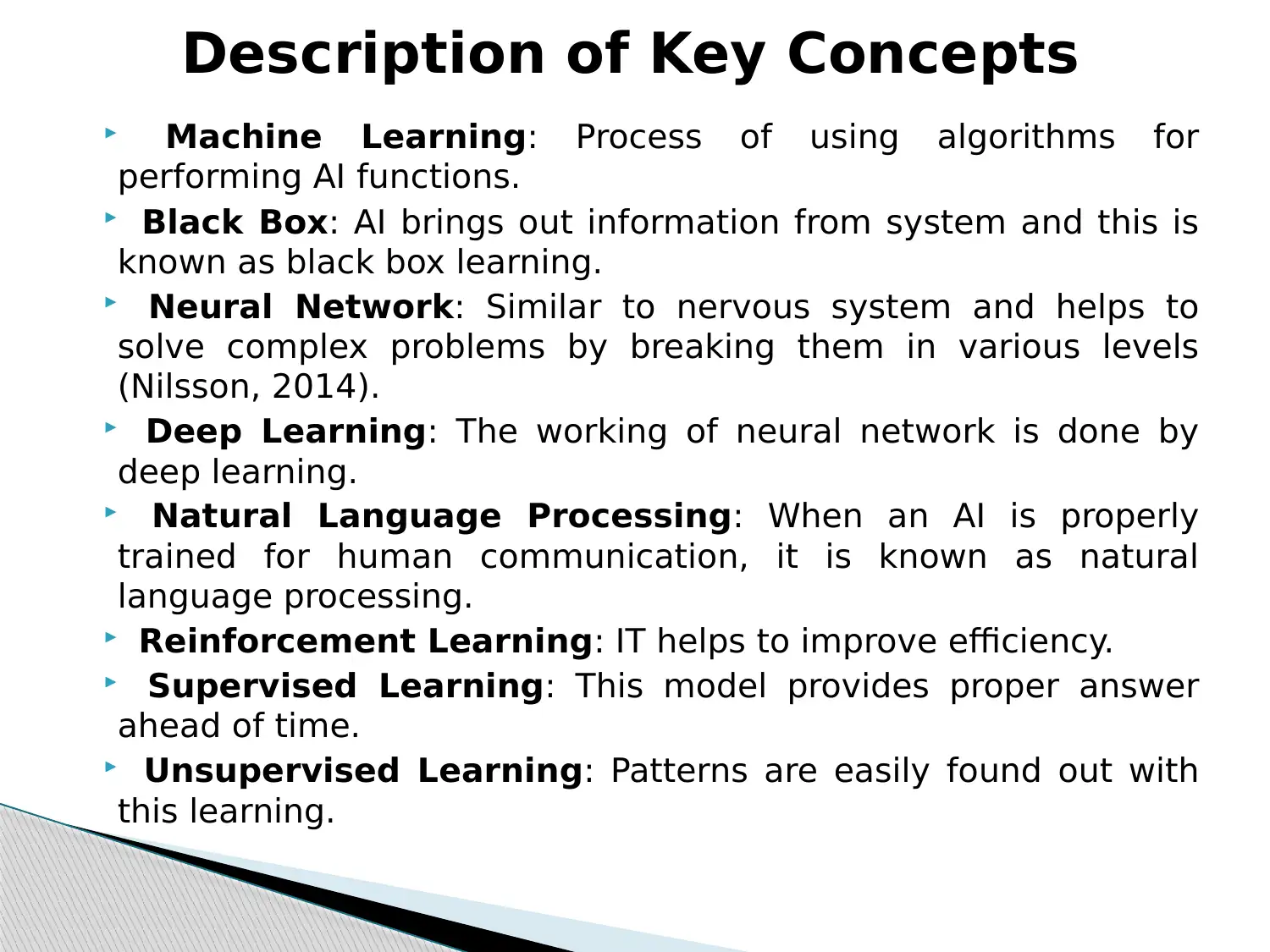
Machine Learning: Process of using algorithms for
performing AI functions.
Black Box: AI brings out information from system and this is
known as black box learning.
Neural Network: Similar to nervous system and helps to
solve complex problems by breaking them in various levels
(Nilsson, 2014).
Deep Learning: The working of neural network is done by
deep learning.
Natural Language Processing: When an AI is properly
trained for human communication, it is known as natural
language processing.
Reinforcement Learning: IT helps to improve efficiency.
Supervised Learning: This model provides proper answer
ahead of time.
Unsupervised Learning: Patterns are easily found out with
this learning.
Description of Key Concepts
performing AI functions.
Black Box: AI brings out information from system and this is
known as black box learning.
Neural Network: Similar to nervous system and helps to
solve complex problems by breaking them in various levels
(Nilsson, 2014).
Deep Learning: The working of neural network is done by
deep learning.
Natural Language Processing: When an AI is properly
trained for human communication, it is known as natural
language processing.
Reinforcement Learning: IT helps to improve efficiency.
Supervised Learning: This model provides proper answer
ahead of time.
Unsupervised Learning: Patterns are easily found out with
this learning.
Description of Key Concepts
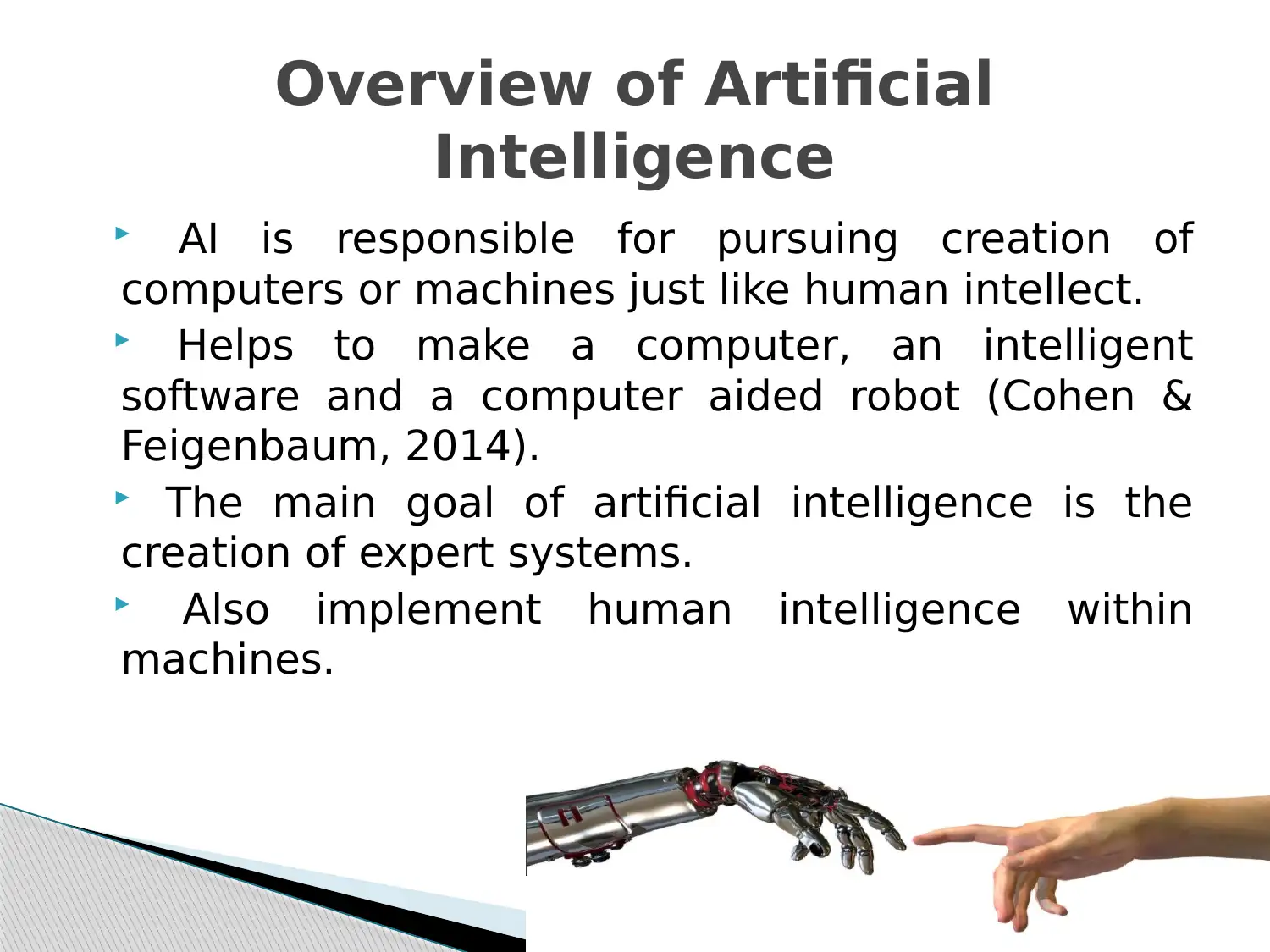
AI is responsible for pursuing creation of
computers or machines just like human intellect.
Helps to make a computer, an intelligent
software and a computer aided robot (Cohen &
Feigenbaum, 2014).
The main goal of artificial intelligence is the
creation of expert systems.
Also implement human intelligence within
machines.
Overview of Artificial
Intelligence
computers or machines just like human intellect.
Helps to make a computer, an intelligent
software and a computer aided robot (Cohen &
Feigenbaum, 2014).
The main goal of artificial intelligence is the
creation of expert systems.
Also implement human intelligence within
machines.
Overview of Artificial
Intelligence
Paraphrase This Document
Need a fresh take? Get an instant paraphrase of this document with our AI Paraphraser

The various features of artificial intelligence
are as follows:
Larger Solution Set: AI comprises of
large solution sets.
Learning Ability: It has learning ability
(Wenger, 2014).
Decision Making: AI helps to take fast
decisions.
Rational Thinking: The users have the
ability of rational thinking.
Features of Artificial
Intelligence
are as follows:
Larger Solution Set: AI comprises of
large solution sets.
Learning Ability: It has learning ability
(Wenger, 2014).
Decision Making: AI helps to take fast
decisions.
Rational Thinking: The users have the
ability of rational thinking.
Features of Artificial
Intelligence

The various advantages of artificial intelligence are as
follows:
Lower Error Rate: The rate of error in this technology is
extremely low.
Replacement of Humans: Tedious and repetitive tasks are
not to be done by human beings any more (Hovy, Navigli &
Ponzetto, 2013).
Does not get Affected by Hostile Environments: AI
comprises of the ability to complete all types of dangerous
tasks.
Detection of Frauds: Frauds could be easily detected by
this technology.
Managing Records: Helps in organizing and managing
records.
Advantages of Artificial
Intelligence
follows:
Lower Error Rate: The rate of error in this technology is
extremely low.
Replacement of Humans: Tedious and repetitive tasks are
not to be done by human beings any more (Hovy, Navigli &
Ponzetto, 2013).
Does not get Affected by Hostile Environments: AI
comprises of the ability to complete all types of dangerous
tasks.
Detection of Frauds: Frauds could be easily detected by
this technology.
Managing Records: Helps in organizing and managing
records.
Advantages of Artificial
Intelligence
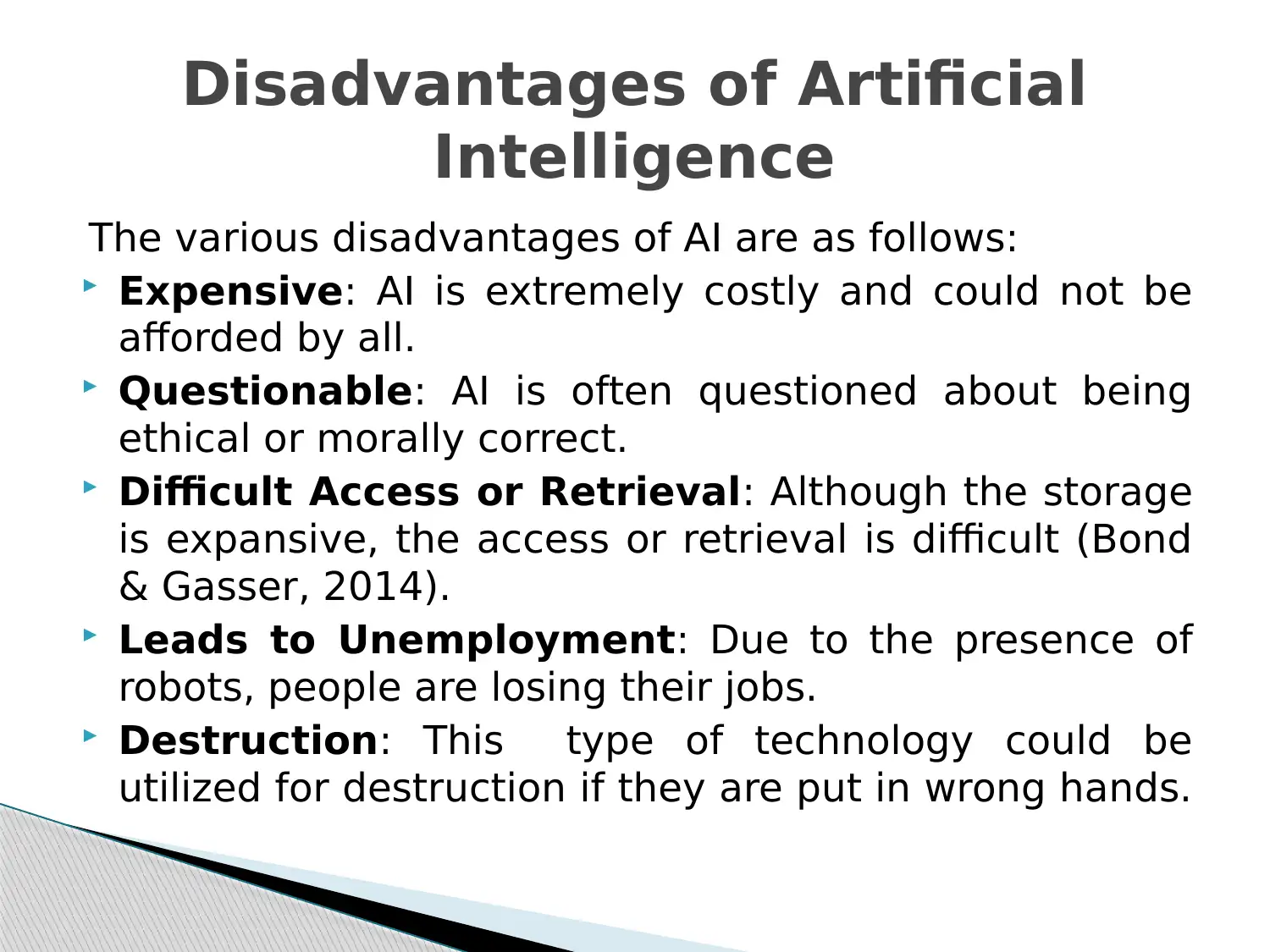
The various disadvantages of AI are as follows:
Expensive: AI is extremely costly and could not be
afforded by all.
Questionable: AI is often questioned about being
ethical or morally correct.
Difficult Access or Retrieval: Although the storage
is expansive, the access or retrieval is difficult (Bond
& Gasser, 2014).
Leads to Unemployment: Due to the presence of
robots, people are losing their jobs.
Destruction: This type of technology could be
utilized for destruction if they are put in wrong hands.
Disadvantages of Artificial
Intelligence
Expensive: AI is extremely costly and could not be
afforded by all.
Questionable: AI is often questioned about being
ethical or morally correct.
Difficult Access or Retrieval: Although the storage
is expansive, the access or retrieval is difficult (Bond
& Gasser, 2014).
Leads to Unemployment: Due to the presence of
robots, people are losing their jobs.
Destruction: This type of technology could be
utilized for destruction if they are put in wrong hands.
Disadvantages of Artificial
Intelligence
Secure Best Marks with AI Grader
Need help grading? Try our AI Grader for instant feedback on your assignments.
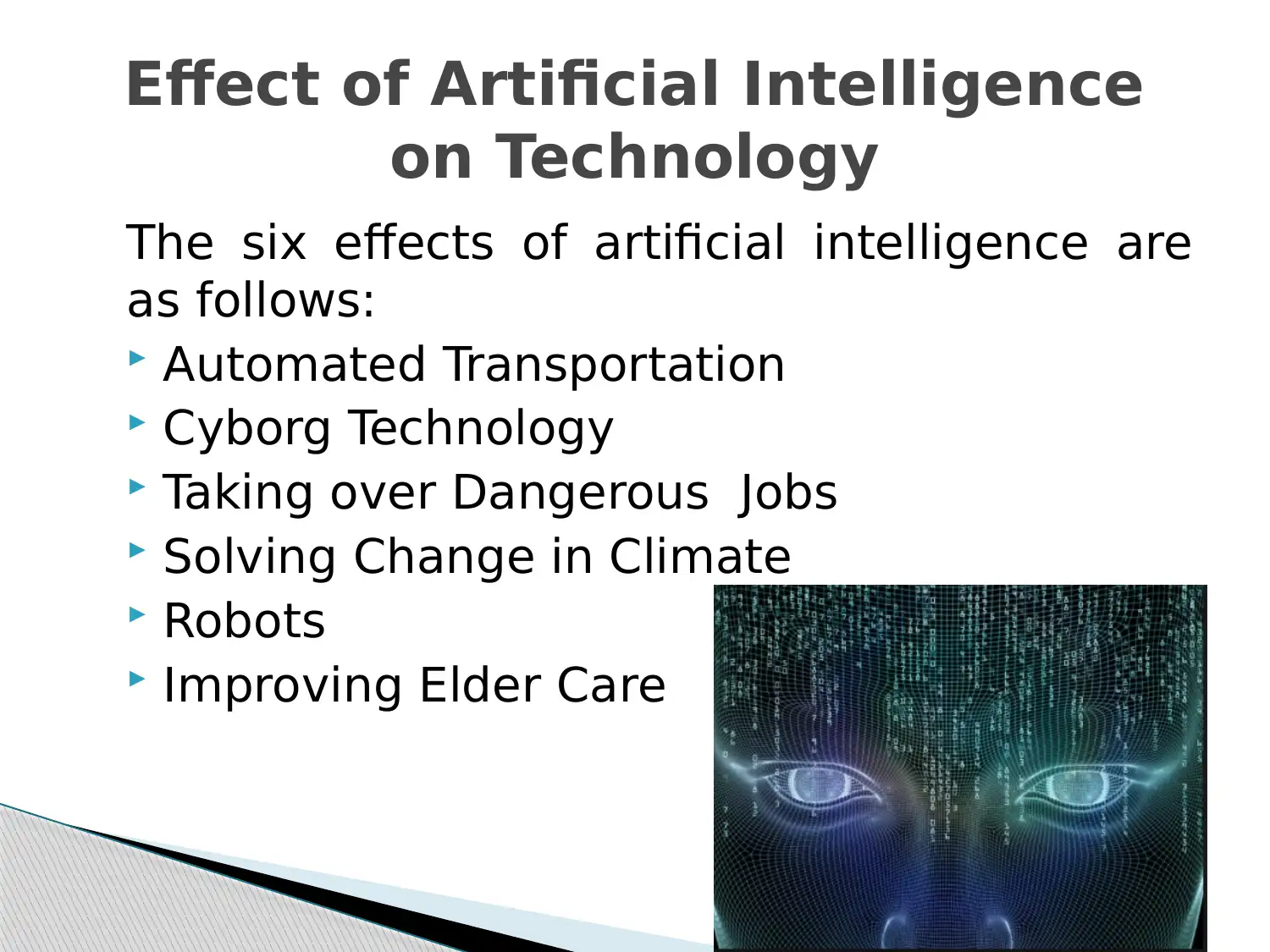
The six effects of artificial intelligence are
as follows:
Automated Transportation
Cyborg Technology
Taking over Dangerous Jobs
Solving Change in Climate
Robots
Improving Elder Care
Effect of Artificial Intelligence
on Technology
as follows:
Automated Transportation
Cyborg Technology
Taking over Dangerous Jobs
Solving Change in Climate
Robots
Improving Elder Care
Effect of Artificial Intelligence
on Technology
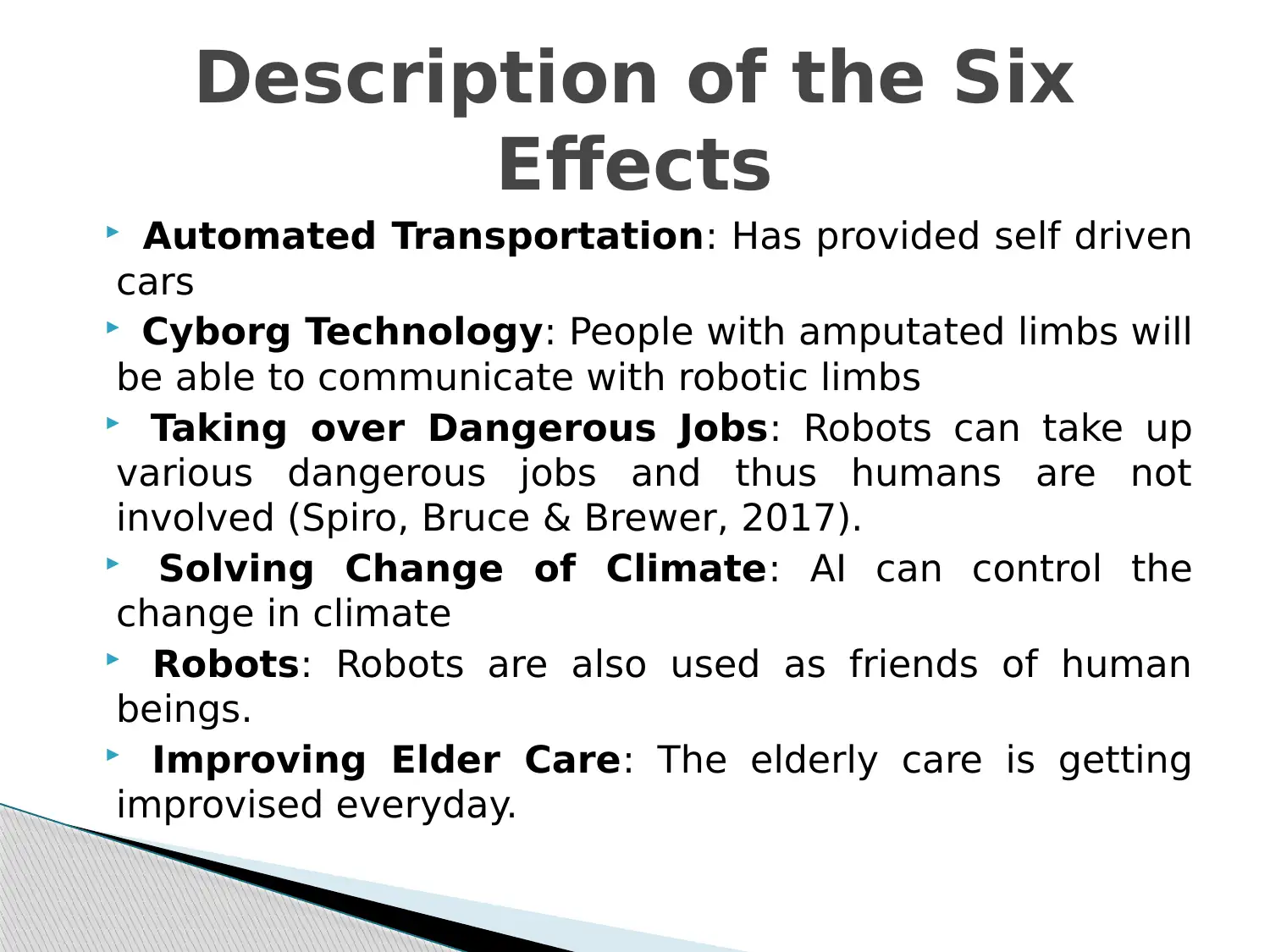
Automated Transportation: Has provided self driven
cars
Cyborg Technology: People with amputated limbs will
be able to communicate with robotic limbs
Taking over Dangerous Jobs: Robots can take up
various dangerous jobs and thus humans are not
involved (Spiro, Bruce & Brewer, 2017).
Solving Change of Climate: AI can control the
change in climate
Robots: Robots are also used as friends of human
beings.
Improving Elder Care: The elderly care is getting
improvised everyday.
Description of the Six
Effects
cars
Cyborg Technology: People with amputated limbs will
be able to communicate with robotic limbs
Taking over Dangerous Jobs: Robots can take up
various dangerous jobs and thus humans are not
involved (Spiro, Bruce & Brewer, 2017).
Solving Change of Climate: AI can control the
change in climate
Robots: Robots are also used as friends of human
beings.
Improving Elder Care: The elderly care is getting
improvised everyday.
Description of the Six
Effects

Automatic Storage Management or ASM is
the integrated as well as higher
performance database file system.
It is based on a basic principle that
database can manage storage for not
requiring any administrator (Nilsson, 2014).
ASM helps to properly manage various
Oracle database management files.
ASM is responsible for automating the
placement of database files.
Automatic Storage Management
the integrated as well as higher
performance database file system.
It is based on a basic principle that
database can manage storage for not
requiring any administrator (Nilsson, 2014).
ASM helps to properly manage various
Oracle database management files.
ASM is responsible for automating the
placement of database files.
Automatic Storage Management
Paraphrase This Document
Need a fresh take? Get an instant paraphrase of this document with our AI Paraphraser
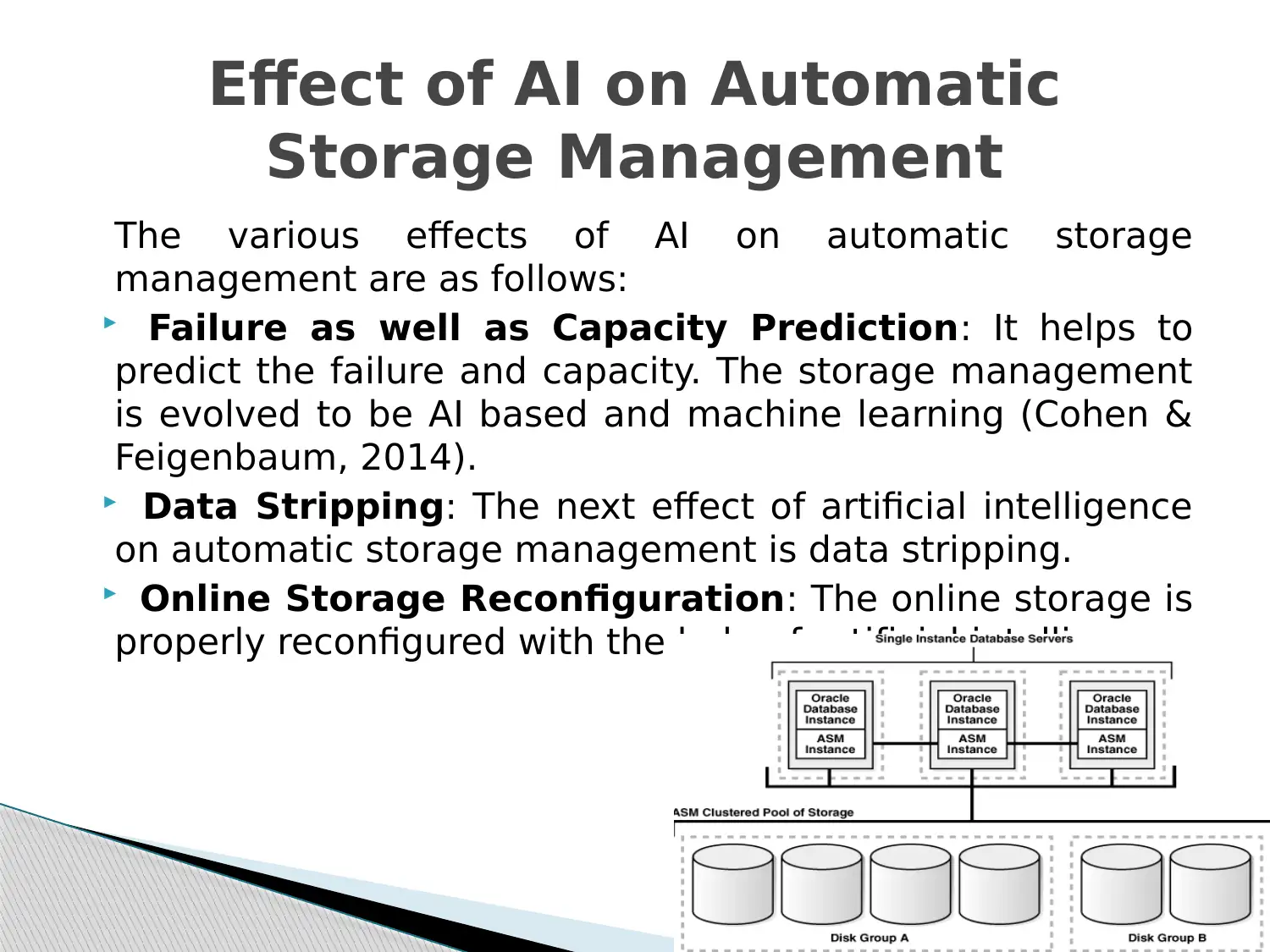
The various effects of AI on automatic storage
management are as follows:
Failure as well as Capacity Prediction: It helps to
predict the failure and capacity. The storage management
is evolved to be AI based and machine learning (Cohen &
Feigenbaum, 2014).
Data Stripping: The next effect of artificial intelligence
on automatic storage management is data stripping.
Online Storage Reconfiguration: The online storage is
properly reconfigured with the help of artificial intelligence.
Effect of AI on Automatic
Storage Management
management are as follows:
Failure as well as Capacity Prediction: It helps to
predict the failure and capacity. The storage management
is evolved to be AI based and machine learning (Cohen &
Feigenbaum, 2014).
Data Stripping: The next effect of artificial intelligence
on automatic storage management is data stripping.
Online Storage Reconfiguration: The online storage is
properly reconfigured with the help of artificial intelligence.
Effect of AI on Automatic
Storage Management
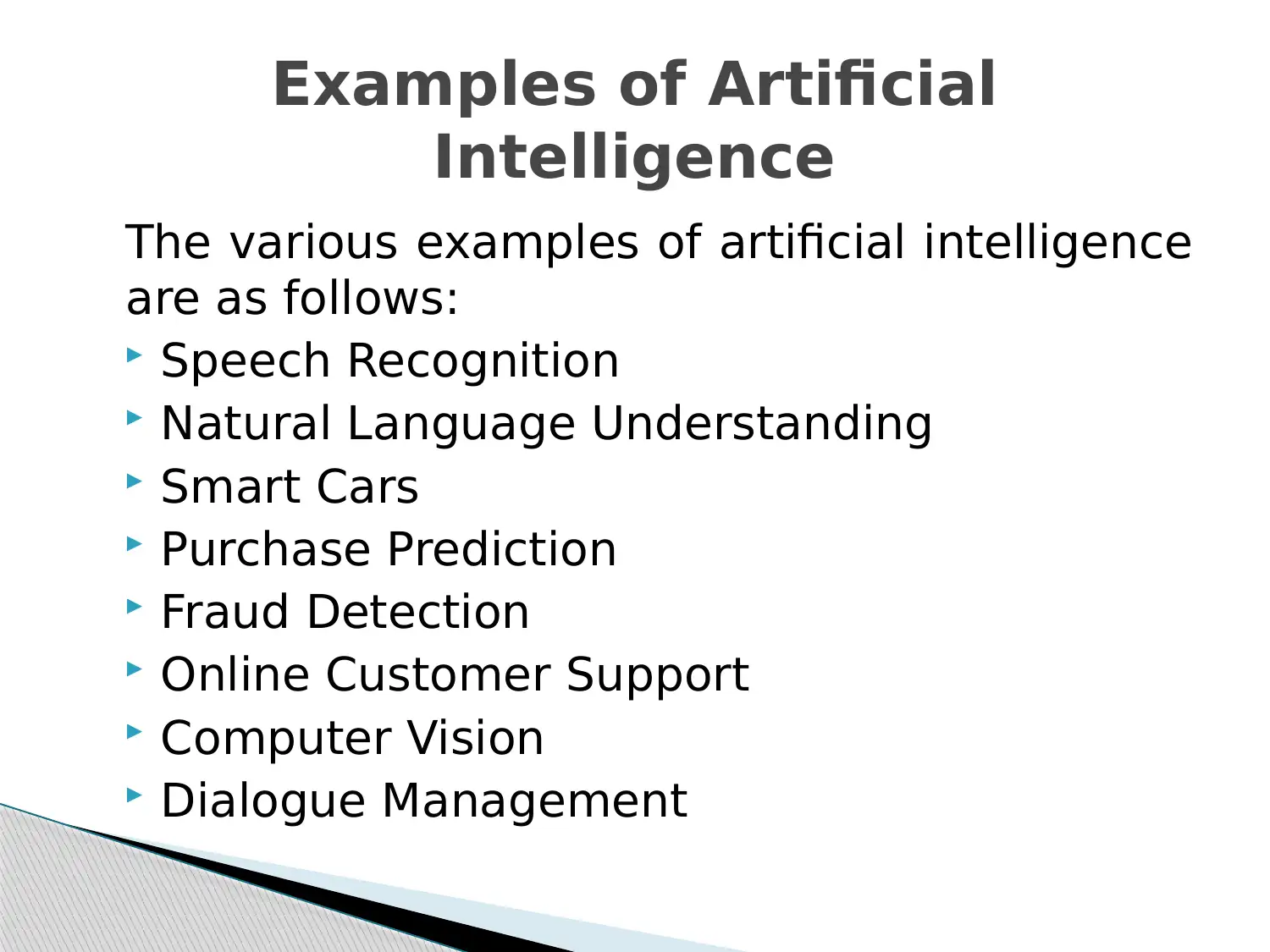
The various examples of artificial intelligence
are as follows:
Speech Recognition
Natural Language Understanding
Smart Cars
Purchase Prediction
Fraud Detection
Online Customer Support
Computer Vision
Dialogue Management
Examples of Artificial
Intelligence
are as follows:
Speech Recognition
Natural Language Understanding
Smart Cars
Purchase Prediction
Fraud Detection
Online Customer Support
Computer Vision
Dialogue Management
Examples of Artificial
Intelligence
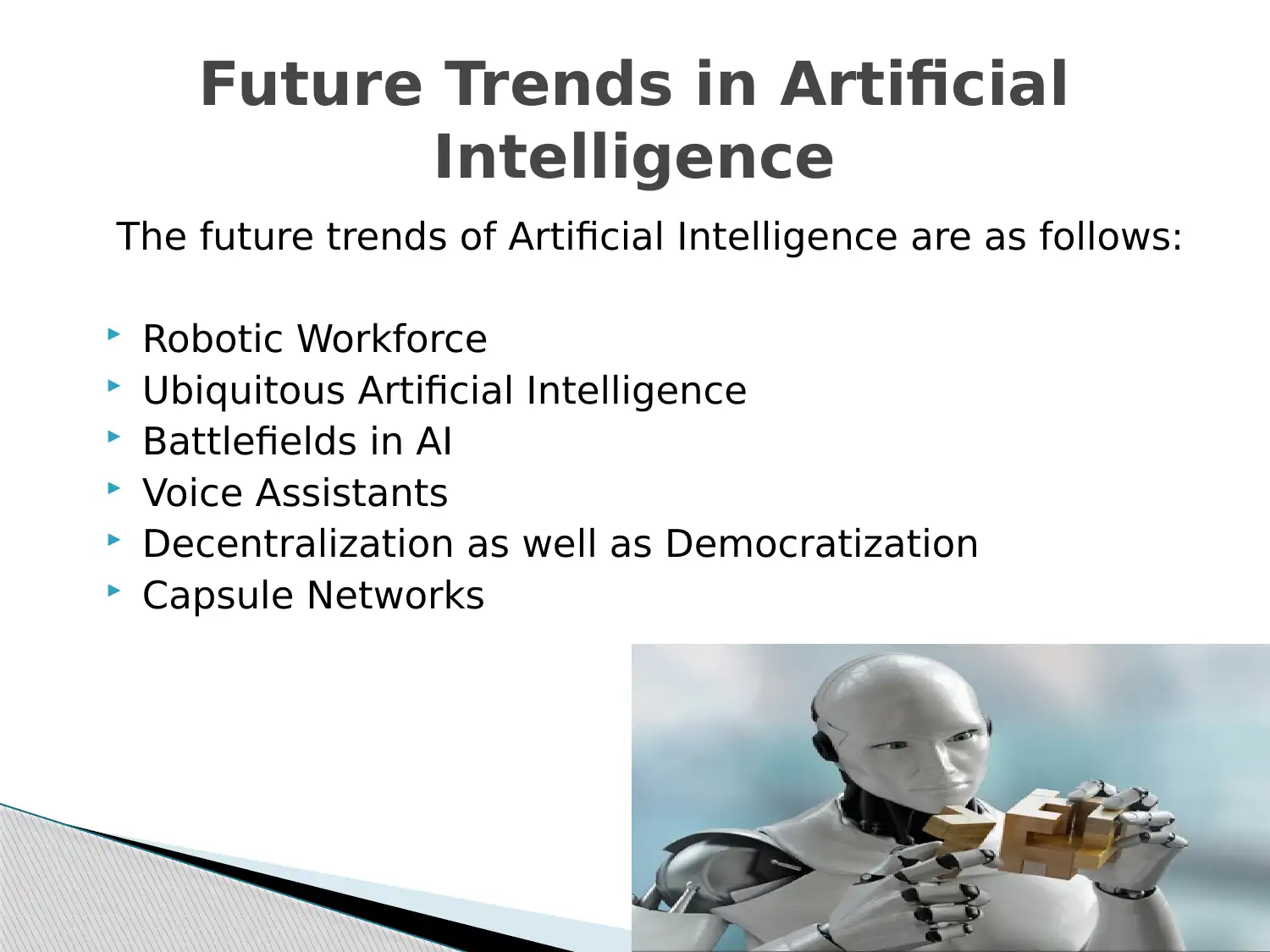
The future trends of Artificial Intelligence are as follows:
Robotic Workforce
Ubiquitous Artificial Intelligence
Battlefields in AI
Voice Assistants
Decentralization as well as Democratization
Capsule Networks
Future Trends in Artificial
Intelligence
Robotic Workforce
Ubiquitous Artificial Intelligence
Battlefields in AI
Voice Assistants
Decentralization as well as Democratization
Capsule Networks
Future Trends in Artificial
Intelligence
Secure Best Marks with AI Grader
Need help grading? Try our AI Grader for instant feedback on your assignments.
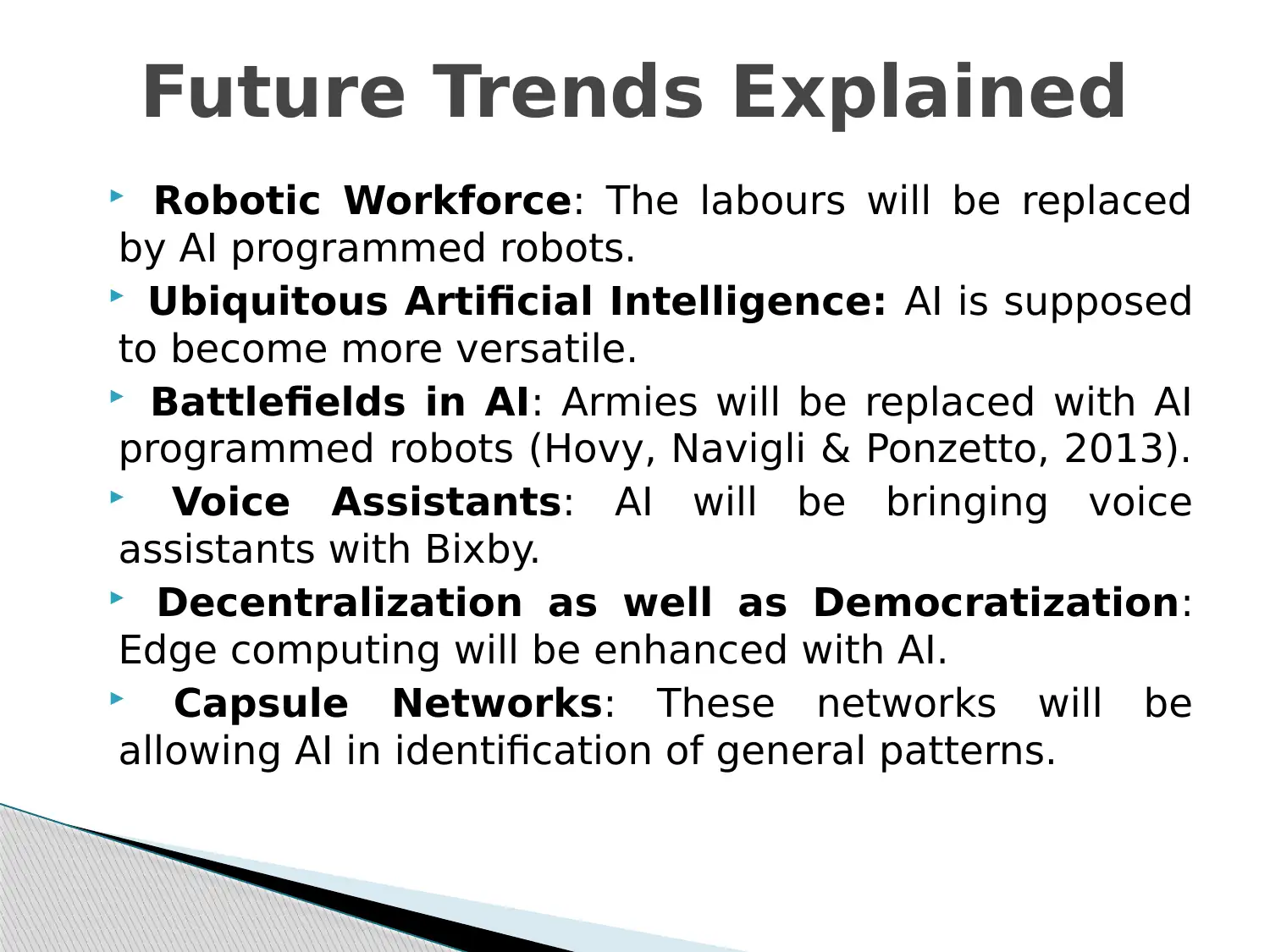
Robotic Workforce: The labours will be replaced
by AI programmed robots.
Ubiquitous Artificial Intelligence: AI is supposed
to become more versatile.
Battlefields in AI: Armies will be replaced with AI
programmed robots (Hovy, Navigli & Ponzetto, 2013).
Voice Assistants: AI will be bringing voice
assistants with Bixby.
Decentralization as well as Democratization:
Edge computing will be enhanced with AI.
Capsule Networks: These networks will be
allowing AI in identification of general patterns.
Future Trends Explained
by AI programmed robots.
Ubiquitous Artificial Intelligence: AI is supposed
to become more versatile.
Battlefields in AI: Armies will be replaced with AI
programmed robots (Hovy, Navigli & Ponzetto, 2013).
Voice Assistants: AI will be bringing voice
assistants with Bixby.
Decentralization as well as Democratization:
Edge computing will be enhanced with AI.
Capsule Networks: These networks will be
allowing AI in identification of general patterns.
Future Trends Explained
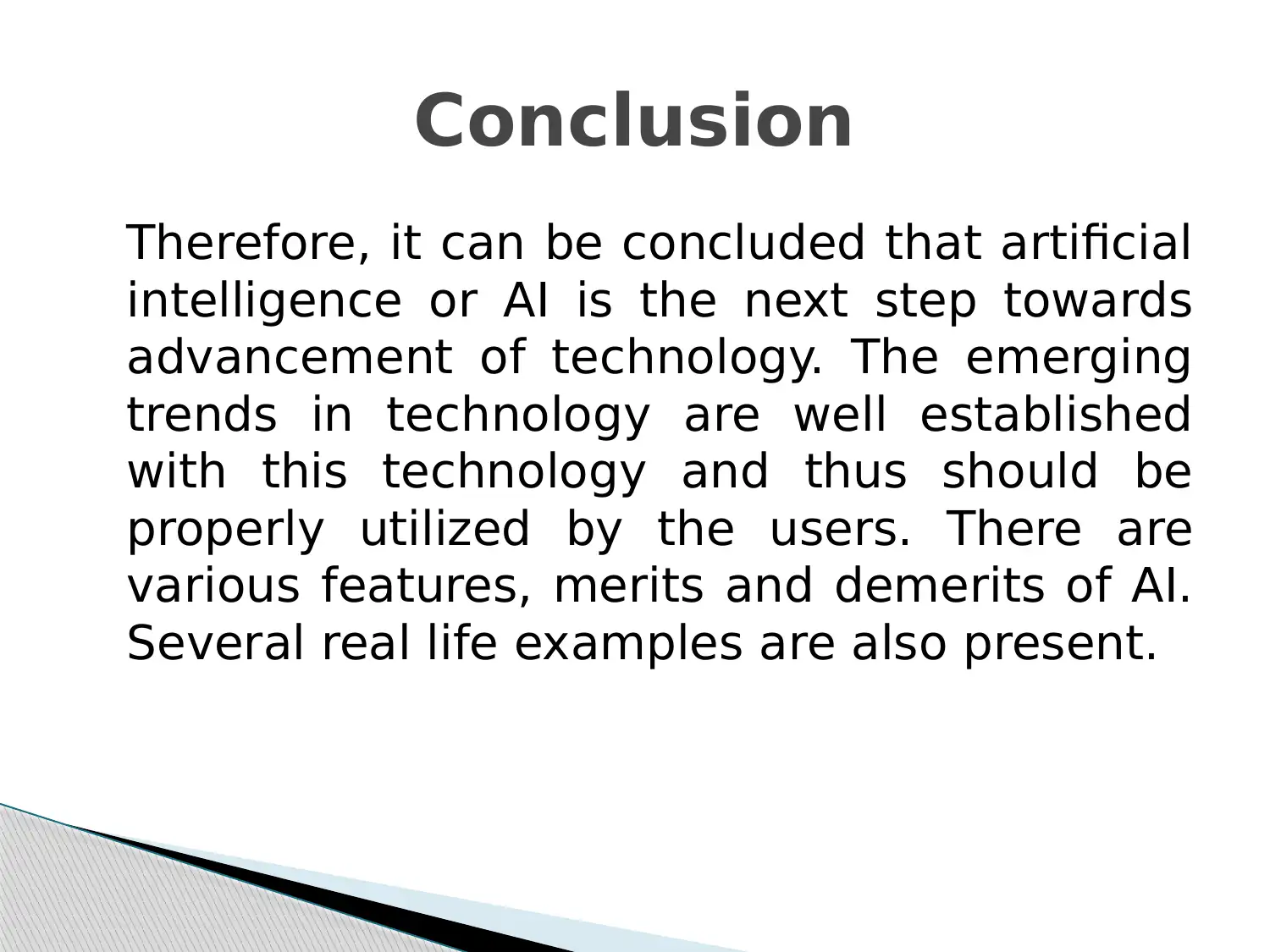
Therefore, it can be concluded that artificial
intelligence or AI is the next step towards
advancement of technology. The emerging
trends in technology are well established
with this technology and thus should be
properly utilized by the users. There are
various features, merits and demerits of AI.
Several real life examples are also present.
Conclusion
intelligence or AI is the next step towards
advancement of technology. The emerging
trends in technology are well established
with this technology and thus should be
properly utilized by the users. There are
various features, merits and demerits of AI.
Several real life examples are also present.
Conclusion
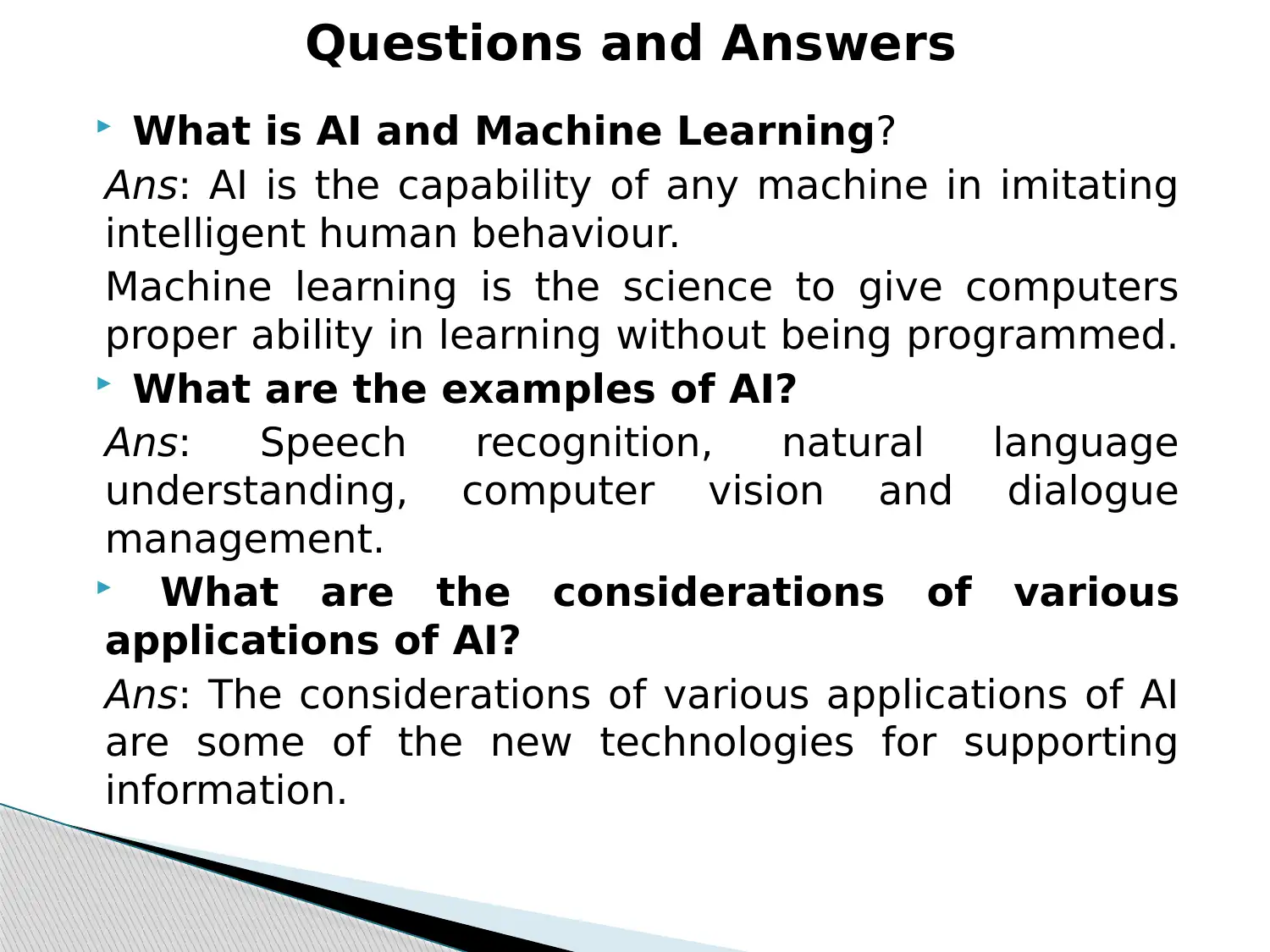
What is AI and Machine Learning?
Ans: AI is the capability of any machine in imitating
intelligent human behaviour.
Machine learning is the science to give computers
proper ability in learning without being programmed.
What are the examples of AI?
Ans: Speech recognition, natural language
understanding, computer vision and dialogue
management.
What are the considerations of various
applications of AI?
Ans: The considerations of various applications of AI
are some of the new technologies for supporting
information.
Questions and Answers
Ans: AI is the capability of any machine in imitating
intelligent human behaviour.
Machine learning is the science to give computers
proper ability in learning without being programmed.
What are the examples of AI?
Ans: Speech recognition, natural language
understanding, computer vision and dialogue
management.
What are the considerations of various
applications of AI?
Ans: The considerations of various applications of AI
are some of the new technologies for supporting
information.
Questions and Answers
Paraphrase This Document
Need a fresh take? Get an instant paraphrase of this document with our AI Paraphraser
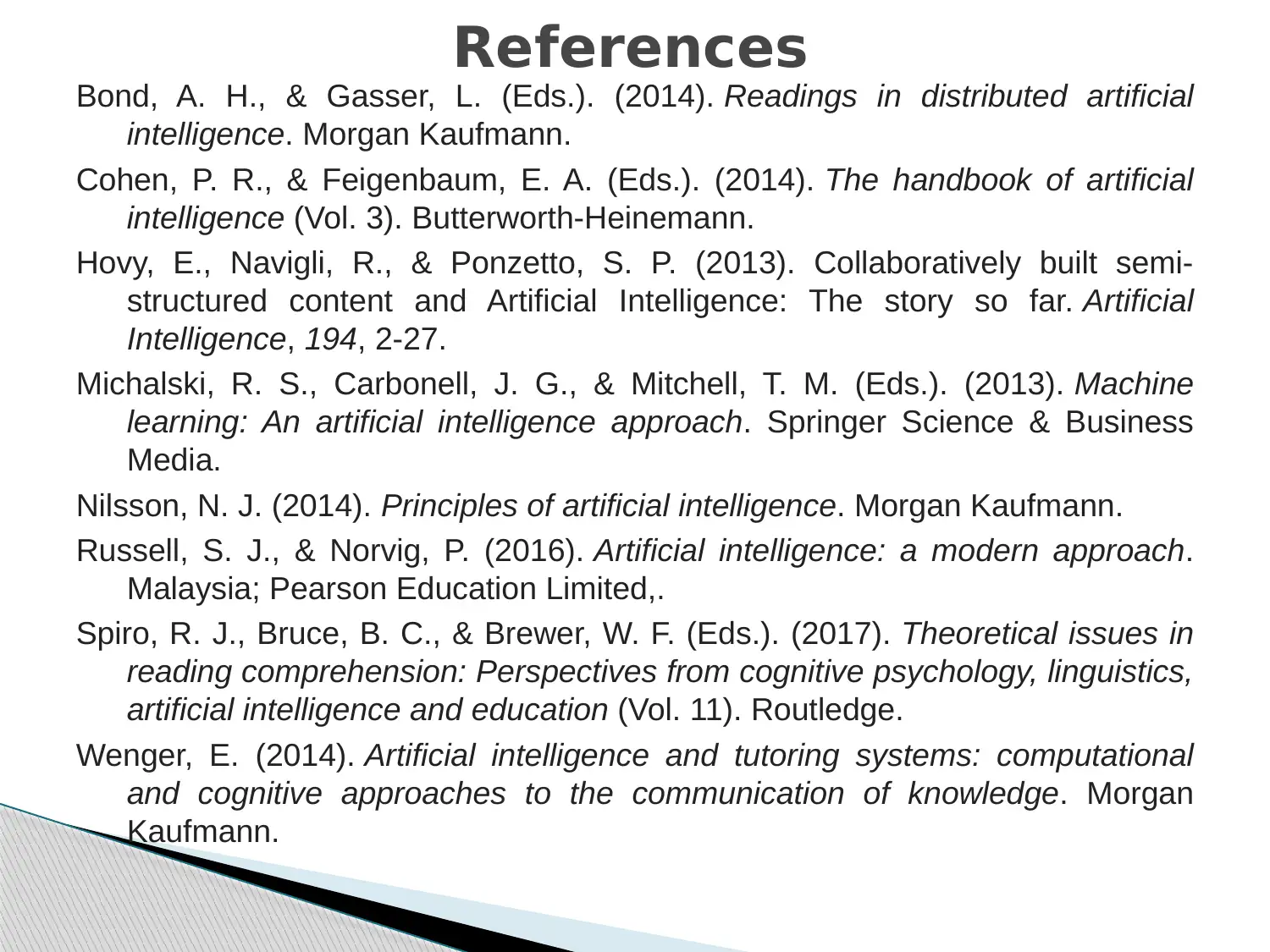
Bond, A. H., & Gasser, L. (Eds.). (2014). Readings in distributed artificial
intelligence. Morgan Kaufmann.
Cohen, P. R., & Feigenbaum, E. A. (Eds.). (2014). The handbook of artificial
intelligence (Vol. 3). Butterworth-Heinemann.
Hovy, E., Navigli, R., & Ponzetto, S. P. (2013). Collaboratively built semi-
structured content and Artificial Intelligence: The story so far. Artificial
Intelligence, 194, 2-27.
Michalski, R. S., Carbonell, J. G., & Mitchell, T. M. (Eds.). (2013). Machine
learning: An artificial intelligence approach. Springer Science & Business
Media.
Nilsson, N. J. (2014). Principles of artificial intelligence. Morgan Kaufmann.
Russell, S. J., & Norvig, P. (2016). Artificial intelligence: a modern approach.
Malaysia; Pearson Education Limited,.
Spiro, R. J., Bruce, B. C., & Brewer, W. F. (Eds.). (2017). Theoretical issues in
reading comprehension: Perspectives from cognitive psychology, linguistics,
artificial intelligence and education (Vol. 11). Routledge.
Wenger, E. (2014). Artificial intelligence and tutoring systems: computational
and cognitive approaches to the communication of knowledge. Morgan
Kaufmann.
References
intelligence. Morgan Kaufmann.
Cohen, P. R., & Feigenbaum, E. A. (Eds.). (2014). The handbook of artificial
intelligence (Vol. 3). Butterworth-Heinemann.
Hovy, E., Navigli, R., & Ponzetto, S. P. (2013). Collaboratively built semi-
structured content and Artificial Intelligence: The story so far. Artificial
Intelligence, 194, 2-27.
Michalski, R. S., Carbonell, J. G., & Mitchell, T. M. (Eds.). (2013). Machine
learning: An artificial intelligence approach. Springer Science & Business
Media.
Nilsson, N. J. (2014). Principles of artificial intelligence. Morgan Kaufmann.
Russell, S. J., & Norvig, P. (2016). Artificial intelligence: a modern approach.
Malaysia; Pearson Education Limited,.
Spiro, R. J., Bruce, B. C., & Brewer, W. F. (Eds.). (2017). Theoretical issues in
reading comprehension: Perspectives from cognitive psychology, linguistics,
artificial intelligence and education (Vol. 11). Routledge.
Wenger, E. (2014). Artificial intelligence and tutoring systems: computational
and cognitive approaches to the communication of knowledge. Morgan
Kaufmann.
References

1 out of 21
Related Documents
Your All-in-One AI-Powered Toolkit for Academic Success.
+13062052269
info@desklib.com
Available 24*7 on WhatsApp / Email
![[object Object]](/_next/static/media/star-bottom.7253800d.svg)
Unlock your academic potential
© 2024 | Zucol Services PVT LTD | All rights reserved.





